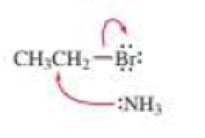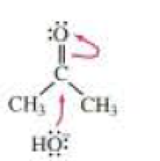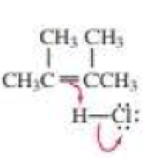
CHEM 262 ORG CHEM EBOOK DIGITAL DELIVERY
8th Edition
ISBN: 2818440043505
Author: Bruice
Publisher: PEARSON
expand_more
expand_more
format_list_bulleted
Concept explainers
Textbook Question
Chapter 5, Problem 54P
By following the curved red arrows, draw the product(s) of each of the following reaction steps. Also indicate which species is the electrophile and which is the nucleophile.



Expert Solution & Answer
Want to see the full answer?
Check out a sample textbook solution
Students have asked these similar questions
In intercalation compounds, their sheets can be neutral or have a negative or positive charge, depending on the nature of the incorporated species and its structure. Is this statement correct?
This thermodynamic cycle describes the formation of an ionic compound MX2 from a metal element M and nonmetal element X in their standard states.
What is the lattice enthalpy of MX2 ?
What is the enthalpy formation of MX2 ?
Suppose both the heat of sublimation of M and the ionization enthalpy of M were smaller. Would MX2 be more stable? Or less? or impossible to tell without more information?
7. Draw the mechanism to describe the following transformation:
Note: This is a base catalyzed reaction. So, the last steps must make [OH]-
OH
[OH]¯
OH
Heat
O
Chapter 5 Solutions
CHEM 262 ORG CHEM EBOOK DIGITAL DELIVERY
Ch. 5.1 - What is the molecular formula for each of the...Ch. 5.1 - Prob. 4PCh. 5.1 - Determine the degree of unsaturation and then draw...Ch. 5.1 - Prob. 6PCh. 5.2 - What is each compounds systematic name?Ch. 5.2 - Prob. 8PCh. 5.2 - Draw the structure for each of the following: a....Ch. 5.3 - How many carbons are in the planar double-bond...Ch. 5.3 - Prob. 12PCh. 5.5 - Prob. 13P
Ch. 5.5 - Prob. 14PCh. 5.5 - Prob. 16PCh. 5.5 - Prob. 17PCh. 5.6 - a. Which of the monosubstituted cyclohexanes in...Ch. 5.6 - a. Calculate the percentage of isopropylcylohexane...Ch. 5.6 - a. for which reaction in each set will S be more...Ch. 5.6 - a. For a reaction with H = 12 kcal/ mol and S =...Ch. 5.8 - Prob. 23PCh. 5.9 - Prob. 24PCh. 5.9 - How many different alkenes can be hydrogenated to...Ch. 5.9 - The same alkane is obtained from the catalytic...Ch. 5.9 - Prob. 27PCh. 5.9 - Rank the following compounds from most stable to...Ch. 5.10 - Prob. 29PCh. 5.10 - Prob. 30PCh. 5.11 - The rate constant for a reaction can be increased...Ch. 5.11 - Prob. 33PCh. 5.11 - a. Which reaction has a greater equilibrium...Ch. 5.12 - Draw a reaction coordinate diagram for a two-step...Ch. 5.12 - a. Which step in the reaction coordinate diagram...Ch. 5.12 - Draw a reaction coordinate diagram for the...Ch. 5.13 - Prob. 38PCh. 5 - What is each compounds systematic name?Ch. 5 - Prob. 40PCh. 5 - Draw the structure of a hydrocarbon that has six...Ch. 5 - Draw the condensed structure for each of the...Ch. 5 - Prob. 43PCh. 5 - Prob. 44PCh. 5 - Prob. 45PCh. 5 - Name the following:Ch. 5 - Prob. 47PCh. 5 - Prob. 48PCh. 5 - Prob. 49PCh. 5 - In a reaction in which reactant A is in...Ch. 5 - Which bond is stronger? Briefly explain why.Ch. 5 - Prob. 52PCh. 5 - Prob. 53PCh. 5 - By following the curved red arrows, draw the...Ch. 5 - Prob. 55PCh. 5 - Prob. 56PCh. 5 - Draw structures for the following: a....Ch. 5 - Prob. 58PCh. 5 - a. Which of the following reactions has the larger...Ch. 5 - Prob. 60PCh. 5 - a. What is the equilibrium constant for a reaction...Ch. 5 - Prob. 62PCh. 5 - Prob. 63PCh. 5 - Given that the free energy of the twist-boat...Ch. 5 - Prob. 65PCh. 5 - Prob. 1PCh. 5 - Prob. 2PCh. 5 - Prob. 3PCh. 5 - Prob. 4PCh. 5 - Prob. 5PCh. 5 - Prob. 6PCh. 5 - Draw curved arrows to show the movement of the...Ch. 5 - Prob. 8PCh. 5 - Prob. 9PCh. 5 - Prob. 10P
Knowledge Booster
Learn more about
Need a deep-dive on the concept behind this application? Look no further. Learn more about this topic, chemistry and related others by exploring similar questions and additional content below.Similar questions
- We are practicing calculating for making solutions. How would I calculate this?arrow_forwardBr. , H+ .OH Mg ether solvent H+, H₂O 17. Which one of the compounds below is the final product of the reaction sequence shown above? HO A HO HO OH D B OH HO OH C OH HO OH Earrow_forward8:57 PM Sun Jan 26 Content ← Explanation Page X Content X ALEKS Jade Nicol - Le A https://www-av C www-awa.aleks.com O States of Matter Understanding consequences of important physical properties of liquids ? QUESTION Liquid A is known to have a lower viscosity and lower surface tension than Liquid B. Use these facts to predict the result of each experiment in the table below, if you can. experiment Liquid A and Liquid B are each pumped through tubes with an inside diameter of 27.0 mm, and the pressures PA and PB needed to produce a steady flow of 2.4 mL/s are measured. 25.0 mL of Liquid A are poured into a beaker, and 25.0 mL of Liquid B are poured into an identical beaker. Stirrers in each beaker are connected to motors, and the forces FA and FB needed to stir each liquid at a constant rate are measured. predicted outcome OPA will be greater than PB OPA will be less than PB OPA will be equal to PB It's impossible to predict whether PA or PB will be greater without more information.…arrow_forward
- Show work. Don't give Ai generated solutionarrow_forward5. Please draw in the blanks the missing transition states and the correlated products. Explicitly display relevant absolute stereochemical configuration. MeOH I OMe H Endo transition state, dienophile approaching from the bottom of diene + H ཎྞཾ ཌཱརཱ༔,_o OMe H H OMe Endo transition state, dienophile approaching from the top of diene or from the bottom but horizontally flipped (draw one) + Exo transition state, dienophile approaching from the top of diene or from the bottom but horizontally flipped (draw one) Exo transition state, dienophile approaching from the top of diene or from the bottom but horizontally flipped (draw one) MeO H H MeO H MeO H MeO H Harrow_forwardH H (1) H C. C C .H (2) (3) Cl H The ideal value for bond angle (1) is (Choose one) and the ideal value for bond angle (3) is (Choose one) degrees, the value for bond angle (2) is (Choose one) degrees, degrees.arrow_forward
- Show work.....don't give Ai generated solutionarrow_forwardShow work. Don't give Ai generated solutionarrow_forward10. Complete the following halogenation reactions for alkanes. Draw the structures of one of the many possible products for each reaction. Name the reactant and product. a) CH₂- CH-CH2-CH3 + Br₂ CH₂ UV UV b) + Cl2 c) CH3-CH₂ CHICHCHICH-CH CH₂-CH₂ + F2 UVarrow_forward
arrow_back_ios
SEE MORE QUESTIONS
arrow_forward_ios
Recommended textbooks for you
 Organic Chemistry: A Guided InquiryChemistryISBN:9780618974122Author:Andrei StraumanisPublisher:Cengage Learning
Organic Chemistry: A Guided InquiryChemistryISBN:9780618974122Author:Andrei StraumanisPublisher:Cengage Learning

Organic Chemistry: A Guided Inquiry
Chemistry
ISBN:9780618974122
Author:Andrei Straumanis
Publisher:Cengage Learning
Coenzymes and cofactors; Author: CH15 SWAYAM Prabha IIT Madras;https://www.youtube.com/watch?v=bubY2Nm7hVM;License: Standard YouTube License, CC-BY
Aromaticity and Huckel's Rule; Author: Professor Dave Explains;https://www.youtube.com/watch?v=7-BguH4_WBQ;License: Standard Youtube License